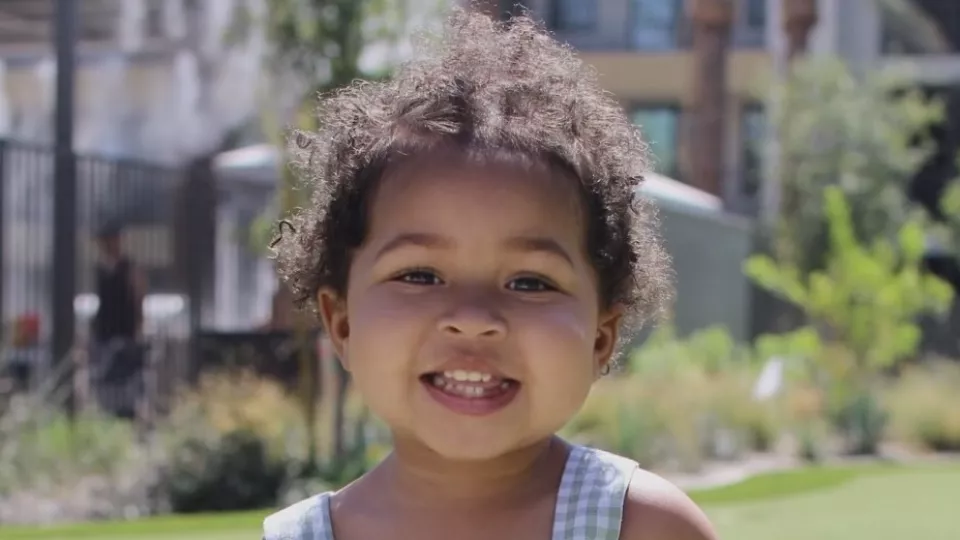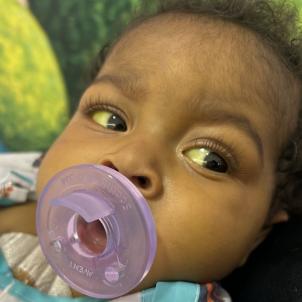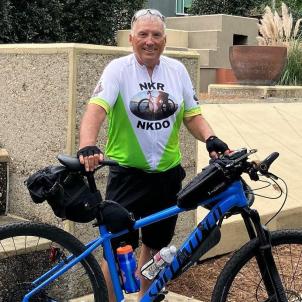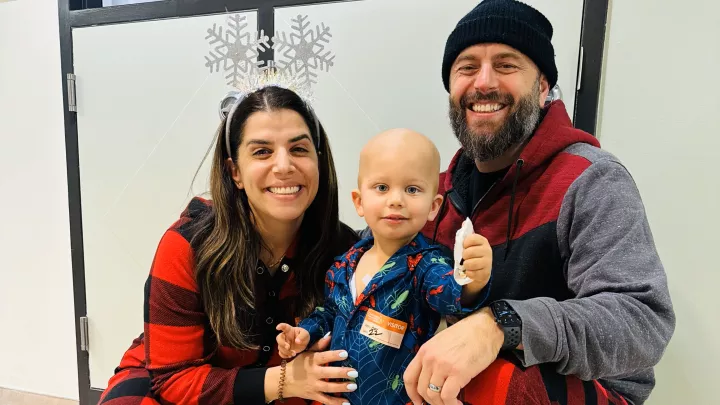
A 67-Year-Old Donor’s ‘Sliver of Liver’ Saves a Baby’s Life
Fast Facts on CHLA’s Liver Transplant Program:
- Best outcomes for pediatric liver transplants in the country
- One-third of donated livers come from living donors
- Tied for third-most pediatric liver transplants performed
“How Selena Met Mark” is unusual and random, and yet a story that ultimately comes around to make great sense—and good science.
In their first encounter, Selena met only a piece of Mark—his liver, specifically, and only a small slice of it. “A sliver of my liver,” Mark likes to say.
Mark Scotch was, and still very much is, a living donor who matched with Selena through the Children’s Hospital Los Angeles living donor liver transplant program, one of the few and busiest programs of its kind in the U.S. One-third of transplanted donor livers at CHLA come from living donors.
So what was so unusual about how the two connected? First, Scotch was not family. “It happens, but it’s uncommon,” says CHLA surgeon Kambiz Etesami, MD, Director of Abdominal Transplantation and Surgical Director of the Liver Transplant Program, who assisted in performing Selena’s transplant.
And random? Scotch was an altruistic liver donor—now more commonly called “non-directed,” Dr. Etesami says, meaning his liver could go to whoever needed it. It didn’t take long before it found Selena.
Liver failure caused by biliary atresia
Why Selena met Mark? Now that’s a much more straightforward tale.

Selena was born with biliary atresia, a disorder that inflames and scars the bile ducts, preventing bile—a green-yellow fluid—from flowing out of the liver and through the ducts and eventually into the small intestine. Because of the blockage, bile gets stuck in the liver, damaging the organ and, eventually, causing it to fail.
“It's the most rapidly progressive fibrotic disease of the liver, period,” CHLA hepatologist and gastroenterologist Keith Hazleton, MD, says. “It causes incredibly fast scarring of the liver.”
Though a congenital disease, biliary atresia can’t be detected before birth, but it’s typically identified early, since its symptoms—a yellowing of the skin and eyes—are apparent to anyone. And when caught early, an intervention called the Kasai procedure establishes bile flow to the intestines through a direct connection to the liver.
The surgery is ideally performed shortly after birth, but Selena’s case wasn’t caught until she was 6 months of age. Dr. Hazleton says that can happen because jaundice has other causes that are more common and harmless, including what’s called breast milk jaundice, where substances in breast milk disrupt the liver’s ability to process bilirubin.
A biopsy of Selena’s liver confirmed the diagnosis—a blockage in the bile ducts. Since she was not eligible for the Kasai procedure, the only option available was a transplant, and at 6 months old she was already a quarter of the way through the two-year range for her survival if her liver went untreated.
“Unfortunately,” Dr. Hazleton says, “this condition is fatal without treatment by two years of age—100% of the time.”
A living donor emerges
To increase Selena’s chances at getting a liver transplant, doctors advised her mother, Liliana, to take Selena to Children’s Hospital Los Angeles so she could be a candidate for live donor liver transplantation, as the local pediatric center in Arizona could not offer that to her.

After being evaluated at CHLA in early spring of 2023, she was placed on the waiting list for liver transplantation, and the process of evaluating potential live donors began.
Meanwhile, Selena’s condition declined. “Her belly started getting round and hard, and her skin went completely yellow,” Liliana says. “Her eyes were a green-yellow. She was getting worse, not just on her labs and tests. You could see it happening.”
In late May 2023, Selena’s wait for a donor ended after a brief two months when she matched with Scotch, who three years earlier was introduced to organ donation after an idle chat with a man in a Louisiana bar ended in Scotch’s volunteering to give the man his kidney.
He has since become a vigorous advocate, riding his bike across the U.S. along “The Organ Trail,” as he named it, to bring attention to the dire need for donors, traveling the same routes taken by his donated organs. His first ride took him from his home in Madison, Wisconsin to Baton Rouge, Louisiana. Though his kidney ended up going to someone in New York because it didn’t match with the guy in the bar, the ride commemorated their fateful meeting.
To get his message out, Scotch pitches media outlets to cover his journeys. “An old guy riding a bike with one kidney,” he says. “Isn’t that an interesting story?”

The “Today” show and PBS, among others, certainly thought so. Additionally, transplant centers have joined with Scotch in promoting organ donorship as he rides through their town.
Scotch came into Selena’s life as the result of appearing at one such event at longstanding CHLA partner Keck Medical Center of USC, where he was encouraged to get an evaluation at the center’s Living-Donor Liver Program. He was rejected because doctors would need to remove too much of his liver to allow it to still function for Scotch. The portion they could safely take was not enough to give to an adult.
“I thought, well, I’m off the hook,” Scotch says.
Not so fast, he found out. His liver was just fine for donating to a child, who needed a much smaller cut of it. His name was placed on the living donor registry for liver in October 2022. Months later it matched with Selena.
Dual surgeries were performed May 25, 2023, timed so that the segment of Scotch’s liver was removed at Keck Hospital, transported to CHLA, and implanted into Selena within a matter of hours.
Doubts about an older donor
What distinguished Selena’s transplant was the age of the donor. At the time of the donation, Scotch was 67. That’s far past the age limit most hospitals apply to living donors, and on first consideration, seems illogical.
“Most centers would say less than 50 years old for the donor,” Dr. Etesami says. “He was probably one of the oldest donors in the country ever, if not the oldest.”
The idea of a 67-year-old man’s liver being suitable for an infant challenges common sense. One would figure that a liver depreciates like an automobile—the more usage, the more wear and tear on it, the less value it has.
“You’re thinking, the younger the donor, the more longevity there is in the organ,” Dr. Etesami says. “While generally true, an exact cutoff age is not really based on concrete science. There's no 1-to-1 correlation between the age of the person and the age of their organ.”
CHLA transplant surgeon Kambiz Etesami, MDThere's no 1-to-1 correlation between the age of the person and the age of their organ.
He explains that the liver, unique among all organs, renews itself. Only about 20% of an adult liver—the left lateral lobe—is taken and transplanted into an infant. The portion that was left alone will soon regrow almost in full, with new cells generating and original tissue enlarging. Additionally, since only a small piece of liver is removed, the surgery presents far less risk to the donor than if a larger segment was being removed for transplant into an adult.
Dr. Etesami notes that the health of the donor is more telling than the age. Scotch, who has competed in several ultra-endurance cycling events—“I’ve done 160-mile races in the middle of winter, 20 below zero,” he says—is in superior shape.
“If you have a perfectly healthy 60-something-year-old who wants to donate a small portion of the liver,” Dr. Etesami says, “although historically this hasn’t been done routinely, cases like Selena’s help to demonstrate that maybe they merit consideration.”
After the liver transplant
Following the same-day surgeries, Scotch had a note sent to Selena’s family to see if they would be interested in meeting him. Liliana responded that they were, and a week later both sides met at CHLA.

“I didn't even know what to say,” Liliana says. “I did thank him. That's the first thing I did. I thanked him and I hugged him.”
They keep up with each other’s lives over the phone. Selena, now 2 ½ and thriving, recognizes Scotch, even if she doesn’t know who he is yet.
“We show her pictures,” Liliana says. “I talked to Mark the other day and she heard his voice and she ran to the phone to say hello.
“We see him like a family friend. We reach out to him and tell him how grateful we are, especially on Selena’s birthday or holidays, or when milestones come around that we know we wouldn't have reached without his generosity.”
A little over a year ago, Scotch visited Liliana’s family at their home. He left with a gift that he now keeps in his office.
“They made a couple of little posters for me,” he says. “One says, ‘Because of you, she lives.’ I’m looking at it right now. It's a heart, a red heart.”
Mark Scotch joined CHLA and Keck Hospital of USC on April 4 at events celebrating National Donate Life Month. Afterward, Scotch began his bike ride back home to Wisconsin, retracing the route his liver took to get to Selena.


